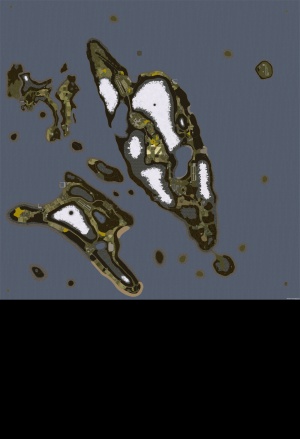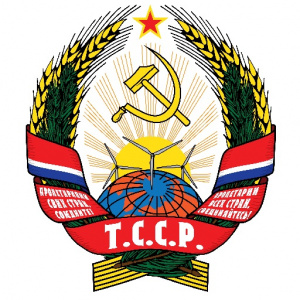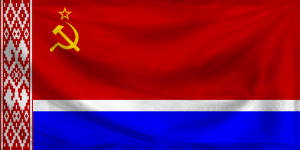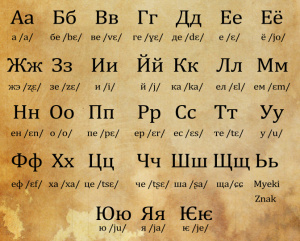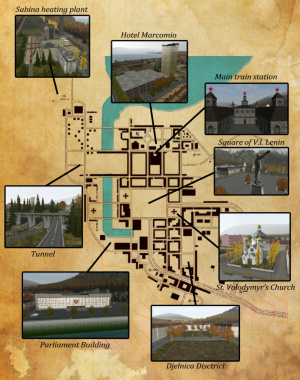About The Islands
Contents
The Island Formation
Taviana S.S.R
Taviana (Officially: Tavianska Sovjetskaja Socialističiskaja Respublika - TSSR– The Soviet Socialist Republic of Taviana) is an island country situated in the Baltic Sea approximately 120km off the coast of Lithuania or Kaliningrad on a volcanic island formation which it shares with Novistrana (Officially: Novistranskaja Sovjetskaja Socialističiskaja Respublika - NSSR - The Soviet Socialist Republic of Novistrana. The Taviana S.S.R has a population of approximately 1 500 000 inhabitants of who 90% are ethnic Slavs called “Rustaki”, Russians or Poles and 10% ethnic Lithuanians. The capital and second largest city of the republic is Sabina which is located on the Southern coast of lake Umag, has a population of approximately 150 000 inhabitants and has the republics main international airport.
The republic is made up of two islands, the bigger of which, on which the capital is located is called Bukvac – named after the mythical Slavic creature which lurks around lakes at night due to the numerous lakes on the island. The smaller island is called Leš (Lesh), named after the Slavic spirit which guards forests at night dude to the islands large forests. The capital of Lesh, and third largest city in the republic is Branibor, situated near the republics only nuclear power station AES Trebljanka.
History
Language
The official spoken language on Taviana is Tavianian (Tavijanski Jazik) which is an Eastern Slavic language written in a variation of the Belarusian Cyrillic alphabet. Lithuanian, Russian and Polish are also officially recognised languages of the republic.
Religion
The largest religious group consisting of 70% of Tavianas population are Orthodox Christians, the second major religious group in the republic are Catholics consisting of approximately 15% population where as 15% of the population have no religion.
Economy
Approximately 50% of the Taviana S.S.R economy consists of the extraction of natural resources such as oil and gas which are drilled mainly on the islands North coasts. Fishing, farming and sea cargo transport form another 35% of the republics economy while heavy industry such as metal works, chemical plants and shipyards from the remaining 15% of the economy.
Sabina (Capital City)
The capital and largest city in the Taviana S.S.R is Sabina. The city was founded in the year 1725 by king Solibor, following the war with Prussian invaders in which he successfully defeated the invaders by taking advantage of the islands terrain despite being outnumbered 5 to 1. The city was named after his wife Sabina who he married in the same year. Legend has it that on the site where St. Volodymyr’s church now stands, a fort used to stand in which queen Sabina was held by the Prussians and rescued by king Solibor himself. The most prominent feature of the city is the statue of Vladimir Illich Lenin in the square of the Republic erected in 1945 after the communist take over. The square of the Republic is also where the notional bank of the Taviana S.S.R is located, as well as the national museum and library. The national museum was built in 1886 alongside the national university located beside it. The capital city also features the national gallery and a number of large shopping centers. Some of the more recent architectural achievements in the capital is the parliament building, based on the GDR parliament building in East Berlin and Hotel Marcomio which is the tallest structure in the city. The capital also contains a 750 meter underground tunnel complete with a train station built in 1948 by the communist party.
Wars
8th Century – The first mention of a mystic group of islands in the Baltic sea in Finno-Ugric folklore is made approximately in the 8th century.
847 – Slavs from the “Rustaki” tribe arrive on today’s Bukvac island from Russia, approximately in the area where today's port of Molotovsk stands and clash with Vikings over control of the islands, eventually dominating them.
1240 – 1241 – In the year 1240, which is the first written account of history on the islands king Haakon IV of Norway is said to have invaded the kingdom by now known as “Rustakiya” in an attempt to conquer the islands but was forced out one year later in the final battle that took place on the fields known today as Stari Bor.
1617 – 1618 - In the years between 1617 - 1618 Rustakiya was invaded by Swedish forces under the leadership of king Gustavus Adoplhus, the then teenage monarch which ruled Sweeden after succeeding his father Charles IX of Sweden. A Swedish navy squadron attacked the then capital Tavistock in today's Novistrana S.S.R while another squadron headed to the gulf of Riga and thus commencing the second phase of the Polish-Swedish war. The Swedes managed to get to the second largest island Leš where they were defeated in the fields where the village of Novi Bor stands today.
1715 – 1725 – Known as the ten year war, this was an era in which the now “Kingdom of Rustakiya” was repeatedly invaded by Prussia. The last battle was fought in the fields around Solibor in today’s Taviana S.S.R in which king Solibor, known as the founding father of the modern Novistrana province apparently defeated the Prussians outnumbered 5 to 1, using the mountains to his advantage. The Kingdom of Rustakia was left severely weakened by the ten year war and in 1742 after king Solibor's death as a result of of pneumonia, his only son Lev wrote to Catherine I, empress of the Russian Empire with a request to become a part of the Russian Empire.
1726 – The Kingdom of Rustakiya becomes a part of the Russian Empire at the request of king Lev and becomes known as the Novistrana territory. A new fortress and eventually capital is built in the North of Bukvac island and is called Ekaterinburg in honor of the Russian empress Catherine I. Orthodox Christianity becomes the religion of the Novistrana province. Until now the Rustaks were pagans who practiced the Slavic paganism.
1890's – A series of uprisings begins in the Novistrana province with the aim to detach from the Russian Empire and establish an independent kingdom. An independent kingdom is briefly declared with its capital in Tavistock, the former capital of the Kingdom of Rustakiya and the capital of todays Novistrana S.S.R. The province however remains divided with the islands of Leš and Bukvac refusing to respect the new capitals authority. The uprising is later crushed and a permanent Russian navy fleet is stationed in the Tavistock area, eventually changing the demographics of the area to mostly Ethnic Russian with Leš and Bukvac remaining ethnically Rustak.
1914–1918 (World war 1) – The years between 1914 – 1918 saw the Bolshevik revolution of 1917 in Russia which gave the Novistrana province independence from the Russian Empire and in which the predominantly ethnic Russian Republic of Novistrana with its capital in Tavistock was born and become a part of the Soviet Union after a brief conflict which saw the island of Leš and Bukvac break away and establish Taviana, which was not a part of the Soviet Union and remained capitalist until World War 2.
1939–1945 (World War 2) – World War 2 was a very dark chapter in the island's history. The islands were invaded by the Third Reich which forced the socialist government of the Republic of Novistrana in to exile in Russia along with the Taviana armed forces which were sent to Gulags in Siberia by Joseph Stalin as punishment for backing the capitalist government during the 1917 revolution. While fighting continued the Jewish population of Taviana was deported to death camps in Poland while the native population of the island's was forced in to labour, manufacturing weapons. The Red Army eventually recaptured the islands at the end of the war.
1945 – The Soviet leader Joseph Stalin seeks to ease ethnic tensions on the islands and crates the Soviet Socialist Republic of Novistrana (SSSN Russian: N.S.S.R ) with the capital Tavistock for the predominantly ethnically Russian North and the Soviet Socialist Republic of Taviana (SSST Russian: T.S.S.R) consisting of the islands of Leš and Bukvac with the capital Sabina for the ethnic Rustaks.
1945 Onwards – From 1945 onwards both republics saw a large number of Lithuanian, Russian and Polish migrants feeling from the destroyed European mainland who took on the task of re-building the republics. Today both republics are still some of the Soviet Union’s key allies and serve as an important strategic location for the Soviet Union as well as an important submarine repair base and airbase. Relations between both republics are also improving steadily.
